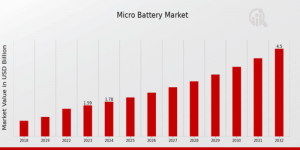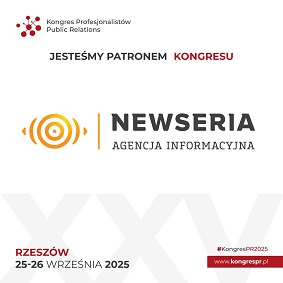Micro Battery Market to grow at strong 12.27% CAGR, achieving value of USD 4.5 Billion by 2032 | Toshiba, Fujitsu, Sony
Growing use in wearable tech and IoT devices is driving strong demand in the global micro battery market.
Micro Battery Market an In-depth Analysis
The micro battery market is emerging as a pivotal segment within the energy storage and power supply industry, driven by the rapid expansion of compact electronic devices and wearable technology. These miniature power sources are integral to products requiring small form factors without compromising performance and energy density.
Micro batteries, ranging from thin-film and printed batteries to button cells and solid-state variants, are finding increasing adoption across medical devices, smart cards, wireless sensors, and Internet of Things (IoT) applications. With the demand for portable electronics and sensor-driven technologies continuing to grow globally, the micro battery market is projected to witness robust expansion in the coming years.
Micro batteries are compact energy storage solutions characterized by small dimensions, lightweight design, and tailored energy capacities, ideal for miniature electronic applications. These batteries are often embedded in devices with limited space, such as smartwatches, hearing aids, fitness trackers, implantable medical devices, and RFID tags.
Get Free Sample PDF Brochure: https://www.marketresearchfuture.com/sample_request/8471
Key Companies in the Micro Battery Market Include:
LG Chem
Panasonic
Duracell
Maxell Holdings
Nippon Kasei Chemical
Fujitsu
Energizer
Coulomb Technologies
Murata Manufacturing
Varta AG
Samsung SDI
Toshiba
Sion Power
Sony
Energizer Holdings
Market Trends Highlights
One of the prominent trends in the micro battery market is the increased focus on flexible and solid-state batteries. Solid-state micro batteries eliminate the need for liquid electrolytes, enhancing safety and making them more suitable for compact applications. Flexible micro batteries are gaining traction for their ability to conform to irregular shapes, which is particularly beneficial for wearable and foldable electronics. Additionally, the integration of micro batteries with energy harvesting technologies—such as piezoelectric, thermoelectric, and photovoltaic systems—is being explored to enable self-powered IoT devices, reducing the dependence on frequent battery replacements.
Another significant trend is the growing interest in thin-film micro batteries, especially in the medical and industrial sectors. These batteries offer high energy density and are ultra-thin, making them suitable for low-power medical implants, smart patches, and ID cards. Meanwhile, advancements in manufacturing techniques, including 3D printing and roll-to-roll fabrication, are contributing to the scalability and cost-effectiveness of micro battery production.
Market Dynamics
The micro battery market is influenced by a complex set of dynamics that reflect the evolving needs of various end-use sectors. On one hand, the adoption of wearable and implantable medical devices is accelerating due to the aging global population and growing health awareness. These devices necessitate reliable and compact energy sources that can operate safely within the human body or in close proximity to it, creating opportunities for biocompatible micro batteries. On the other hand, the increasing deployment of IoT and smart systems in industries like agriculture, logistics, and smart cities is expanding the application scope for wireless sensor networks powered by micro batteries.
Technological innovation acts as a key enabler, yet price sensitivity and energy density limitations remain challenges. Despite their compact size, micro batteries must balance energy output and longevity with cost efficiency. Moreover, market players must navigate stringent safety and environmental regulations concerning battery disposal and toxicity. Therefore, collaborations between material scientists, device manufacturers, and battery developers are crucial to overcoming these hurdles and optimizing performance for specific applications.
Buy Now Premium Research Report: https://www.marketresearchfuture.com/checkout?currency=one_user-USD&report_id=8471
Market Drivers
Several key drivers are propelling the growth of the micro battery market. First, the explosive growth of wearable electronics—including fitness trackers, smartwatches, and AR/VR devices—requires increasingly compact and efficient power solutions. Micro batteries offer a perfect fit for these use cases due to their miniature size and tailored capacity.
Secondly, the surge in demand for minimally invasive medical devices is another powerful driver. Devices such as hearing aids, pacemakers, neurostimulators, and continuous glucose monitors require batteries that are not only small but also reliable and biocompatible. Micro batteries meet these requirements and play a vital role in the functionality of such life-saving technologies.
Thirdly, the proliferation of IoT devices and smart sensors in industrial automation, logistics, asset tracking, and smart home systems is leading to a massive need for energy-efficient and long-lasting micro power sources. As the number of connected devices globally continues to soar, micro batteries are essential for sustaining uninterrupted operations in remote or hard-to-reach areas.
Market Restraints
Despite the positive outlook, several restraints could potentially hinder market growth. Limited energy capacity and short life cycles, especially in extreme environments, are major limitations that can restrict adoption in demanding applications. Although innovations are gradually overcoming these issues, current battery chemistry and design still present certain trade-offs between size, power, and longevity.
Cost and manufacturing complexity are also significant challenges. Producing micro batteries with high precision and reliability, especially those tailored for critical applications like medical implants, can be expensive. This can limit market penetration, particularly in price-sensitive sectors or developing regions.
Micro Battery Market Segmentation Insights
Micro Battery Market Application Outlook
Consumer Electronics
Wearable Devices
Medical Devices
Internet of Things
Energy Harvesting
Micro Battery Market Battery Type Outlook
Lithium-Ion
Lithium Polymer
Solid State
Nickel-Metal Hydride
Micro Battery Market Capacity Outlook
Less than 100 mAh
100 mAh to 200 mAh
200 mAh to 500 mAh
More than 500 mAh
Micro Battery Market End Use Outlook
Personal Care
Healthcare
Industrial
Telecommunications
Browse In-depth Market Research Report: https://www.marketresearchfuture.com/reports/micro-battery-market-8471
Regional Analysis
Geographically, the micro battery market is segmented into North America, Europe, Asia-Pacific, Latin America, and the Middle East & Africa. Asia-Pacific dominates the global market, driven by strong electronics manufacturing bases in China, Japan, South Korea, and Taiwan. The presence of major battery manufacturers and rapid adoption of smart devices in the region contributes significantly to market growth.
North America holds a substantial share, fueled by high R&D investments, the adoption of advanced medical devices, and growing demand for IoT-based systems. The U.S. in particular is a key contributor due to the presence of innovative startups and established tech companies.
Europe is also a strong market, especially in terms of regulatory support for sustainable energy solutions and the growing demand for wearable technology. Countries like Germany and the UK are fostering micro battery adoption in healthcare and industrial applications.
Meanwhile, Latin America and the Middle East & Africa are emerging markets with growing consumer electronics penetration and increased interest in telemedicine and remote health monitoring solutions. These regions offer future opportunities, although market development is currently slower due to infrastructural and economic constraints.
More Related Reports:
OCTG Market: https://www.marketresearchfuture.com/reports/octg-market-1030
Directional Drilling Market: https://www.marketresearchfuture.com/reports/directional-drilling-market-1375
Oil Field Equipment Market: https://www.marketresearchfuture.com/reports/oil-field-equipment-market-1392
Drill Bits Market: https://www.marketresearchfuture.com/reports/drill-bits-market-1614
Oil and Gas Separators Market : https://www.marketresearchfuture.com/reports/oil-gas-separator-market-1809
Oilfield Equipment Rental Services Market: https://www.marketresearchfuture.com/reports/oilfield-equipment-rental-services-market-2515
Smart Well Market: https://www.marketresearchfuture.com/reports/smart-well-market-2623
Kenneth W. Welch Jr. Reveals Spiritual Entrepreneurship Secrets for Global Impact
New Study Establishes Supremacy of Complexity Science and Randomness in Machine Learning for Neurosymbolic Computation
ATA Ushers in a New Era of Intelligent API Management with AI at the Core
Więcej ważnych informacji
 Jedynka Newserii
Jedynka Newserii

 Jedynka Newserii
Jedynka Newserii

Polityka

Polska może się stać Doliną Krzemową Europy. Potrzeba jednak wsparcia finansowego start-upów i mocniejszej deregulacji
Polskie start-upy skoncentrowane są głównie na rozwoju nowoczesnych technologii informatycznych i cyfrowych. Wyraźny nacisk na oprogramowanie i aplikacje oraz big data i data science wskazuje na silne zainteresowanie narzędziami analitycznymi i rozwiązaniami wspierającymi transformację cyfrową w różnych branżach – wynika z raportu „Rynek start-upów w Polsce. Trendy technologiczne”, który został opracowany w 2024 roku w MRiT. Zdaniem europarlamentarzystów Polska ma szansę się stać Doliną Krzemową, jednak rozwój start-upów blokowany jest m.in. przez ograniczony dostęp do finansowania oraz niekorzystne i nadmierne regulacje.
Transport
Na półmetku wakacji ceny paliw na stacjach nie powinny się wyraźnie zmienić. Znaczące różnice między regionami i stacjami

W sierpniu ceny benzyny, oleju napędowego i autogazu powinny pozostać na poziomach z lipca – uważa ekspertka rynku z firmy Reflex. Wyższe będą zawsze na stacjach premium, tych, które oferują bogatszą ofertę dodatkową, promocje dla uczestników programu lojalnościowego, oraz w regionach, w których tradycyjnie paliwa są droższe ze względu np. na wyższą siłę nabywczą mieszkańców. Różnice mogą sięgać kilkudziesięciu groszy na litrze. Obszary, wokół których te wartości oscylują, zależą z kolei od sytuacji globalnej. Warto patrzeć na sytuację na Bliskim Wschodzie i w Ukrainie.
Polityka
A. Mularczyk (PiS): Nawiązanie poważnego dialogu z Niemcami jest konieczne nie tylko w kontekście reparacji. Powinien być podpisany traktat polsko-niemiecki

– Nie wystarczy jednorazowy gest czy inicjatywa. To musi być podjęcie dialogu, być może też przygotowanie nowej umowy bilateralnej, nowego traktatu polsko-niemieckiego, który regulowałby wszystkie obszary, które wynikały ze skutków II wojny światowej – mówi Arkadiusz Mularczyk, poseł do Parlamentu Europejskiego z PiS-u. Podkreśla, że proces ten nie będzie łatwy, bo wymaga konsekwencji i stanowczości, ale widzi szansę w prezydenturze Karola Nawrockiego, który już zadeklarował kontynuację starań w tym zakresie. Zdaniem europosła wsparciem w polsko-niemieckim dialogu może być administracja Donalda Trumpa.
Partner serwisu
Szkolenia

Akademia Newserii
Akademia Newserii to projekt, w ramach którego najlepsi polscy dziennikarze biznesowi, giełdowi oraz lifestylowi, a także szkoleniowcy z wieloletnim doświadczeniem dzielą się swoją wiedzą nt. pracy z mediami.




![Nestlé w Polsce podsumowuje wpływ na krajową gospodarkę. Firma wygenerowała 0,6 proc. polskiego PKB [DEPESZA]](https://www.newseria.pl/files/1097841585/fabryka-nesquik_1,w_85,r_png,_small.png)




.gif)

 |
| |
| |
|